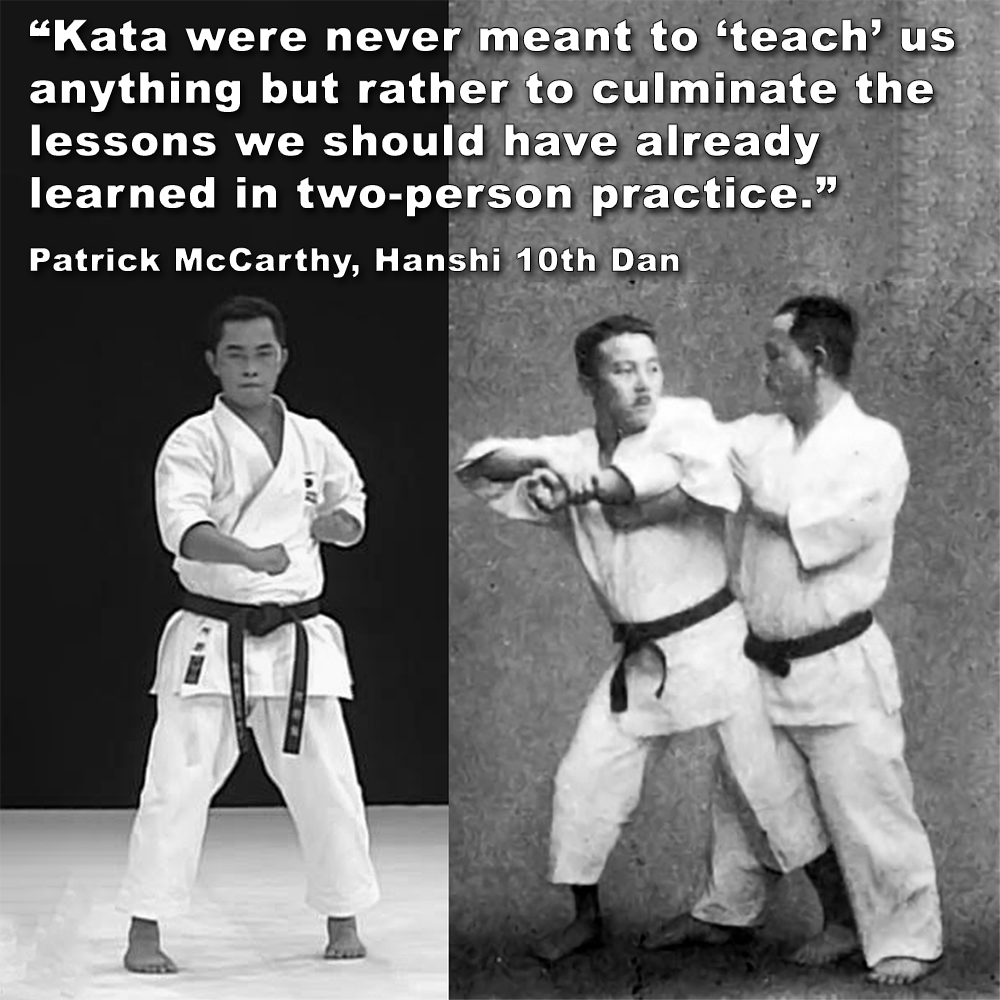
"Kata were never meant to ‘teach’ us anything but rather to culminate the lessons we should have already learned in two-person practice." - Patrick McCarthy
Posted by ADAM CARTER on MAY 29, 2024

"Kata were never meant to ‘teach’ us anything but rather to culminate the lessons we should have already learned in two-person practice." - Patrick McCarthy
(Approx 2 minute 10 second read)
Recently, a comment on one of my articles challenged the notion that kata originated from two-person drills, asserting that “there is no evidence” to support this claim.
This critic argued that kata were devised independently and later had practical applications extracted from them. However, this viewpoint overlooks critical aspects of martial arts training and history.
From my perspective, kata is inherently linked to two-person drills. This assertion is grounded in both logical deduction and historical precedent.
In the early stages of martial arts development, practical combat skills were paramount. Practitioners engaged in paired drills to refine their techniques, and understand real combat dynamics. These drills were essential for learning how to apply techniques against an opponent.
Historical records and oral traditions, suggest that two-person drills were indeed integral to training. These drills allowed practitioners to experience the unpredictability and resistance of an actual opponent, which is crucial for effective combat training.
It makes logical sense, doesn’t it, that the solo practice of kata evolved as a method to record and preserve these combative techniques, without any other means of communication?
Practitioners could not always train with partners, and kata provided a way to practice techniques in the absence of an opponent. The kata also served as a mnemonic device, helping practitioners remember complex sequences and principles of their art.
As the martial arts spread and evolved, the need for a standardized method of teaching became evident. Kata offered a structured and systematic approach to training larger groups of students. It ensured consistency in teaching and allowed for the transmission of techniques across generations.
The counterargument put forward, suggested that kata were created first, with applications being deduced afterward. This view suggested that kata were designed as abstract representations of combat principles, which instructors and students later interpreted into practical applications. However for me, this approach seems somewhat counterintuitive.
If the primary goal of martial arts training was effective combat, why would the original masters devise kata in an abstract form, necessitating a reverse-engineering process to uncover their practical use?
It seems more plausible, doesn’t it, that kata codified existing practices rather than obscured them?
Extracting applications from kata requires a deep understanding of the underlying principles, something that beginner and intermediate practitioners might not possess. Starting with two-person drills ensures that students grasp the practical utility of techniques before moving on to more abstract solo practice.
Practical and historical context strongly supports the idea that two-person drills preceded the development of solo kata.
I believe this progression reflects a logical evolution from direct, hands-on combat training to the structured, methodical practice of kata as a means to preserve and transmit martial knowledge.
Patrick McCarthy, Hanshi 10th Dan, aptly summarized this perspective: “Kata were never meant to ‘teach’ us anything but rather to culminate the lessons we should have already learned in two-person practice.”
This insight underscores the importance of understanding kata not as isolated sequences but as the essence of practical, combative training.
